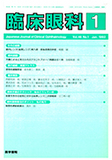Japanese
English
- 有料閲覧
- Abstract 文献概要
- 1ページ目 Look Inside
半導体レーザーによる経強膜毛様体凝固の臨床応用を目的として,有色家兎眼を用いて実験を行った。はじめに予備実験としてアルゴンおよびクリプトンレーザーと強膜透過性を比べたところ,半導体レーザーは最も優れた透過性を示した。次に家兎12羽12眼を用い接触法により経強膜毛様体凝固を襞部・扁平部の2群に分け施行した。両群とも凝固1週以内では約10mmHgの眼圧差があったが,その後,圧差は減少し,1か月以降20週まで約5mmHgの圧差が続いた。組織学的には襞部凝固で,毛様体実質の菲薄化や上皮層の変性・消失が著明であった。扁平部凝固では凝固部の穿孔が起きやすかったが,1か月後では穿孔部は線維芽細胞で置換され,襞部まで広範な上皮層の消失があり,房水産生抑制による眼圧下降の可能性が考えられた。
We attempted cyclophotocoagulation in pigment-ed rabbit eyes with diode laser at 810 nm. Prelimi-nary experiments with dissected sclera showed better transmission for diode than argon or krypton lasers. Cyclophotocoagulation was then performed in 12 rabbit eyes either through pars plicata or pars plana. In both groups,the intraocular pressure immediately decreased by about 10 mmHg with a tendency to recover one week later. Theintraocular pressure remained 5 mmHg less than the pretreatment value for 4 to 20 weeks. His-tologically, there was destruction of the ciliary body and disruption of the epithelial layers after pars plicata coagulation. Perforation of the ciliary body was frequent after pars plicata coagulation, to be replaced later by fibroblasts. This feature seemed to be the cause of the persistent intraocular pressure reduction after pars plana photocoagula-tion.

Copyright © 1992, Igaku-Shoin Ltd. All rights reserved.


